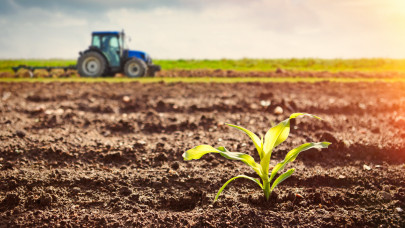Frankfurt, Germany, June 26, 2018 – Germany is using record quantities of timber. Domestic consumption of raw wood materials is currently about 135 million cubic meters per year, and approximately half of that is used to produce energy. Even companies without their own woodlands can produce timber by cultivating short-rotation wood, which are increasingly found in agricultural businesses because of their fast growth and high yields. Poplars, willows, robinia or ash, alder and birch are all being cultivated for biomass, and these trees can be grown on land that is problematic for growing other crops because of its geographic location or soil type.
Short-cycle woodland is harvested every two to eight years, and the cultivation is considered to be profitable if more than eight tonnes of wood per hectare is produced annually. Once planted, a yield of about 1,000 tonnes of biomass can be expected during a 20-year management period. And this type of production is not just positive from an economic point of view; biomass from timber CO2-neutral and causes less climate-damaging emissions than fossil fuels when grown within sustainable forest management.
The economics of short-rotation plantations are influenced by the method of harvesting the biomass. Woodland forage harvesters, intended for front or rear attachment to tractors, can be used that will directly process sticks up to up to 13 centimeters in diameter into field-fresh wood chips with a moisture content of 55 percent with their corresponding drying requirement. Alternatively, conventional felling and stacking methods can be used, with the advantage that chopping into woodchip can be done at a later date, with a reduced moisture level.
Heat and electricity from wood gasifier systems
Farmers with short-rotation woodland can benefit from modern woodchip heaters, that comfortably provide homes, animal housing and outbuildings with heat, but agricultural businesses that need a lot of energy – for example to power energy-intensive feeding systems, infrared lamps, fans or pumps – can further reduce their costs by using combined heat and power plants (CHPs). Manufacturers of wood gasification CHPs have made great progress in the development of their technology in recent years, and modern systems, such as those that will be on show at EnergyDecentral at Hanover's Exhibition Center in mid-November, are now able to achieve availability levels of more than 90 percent.
Wood gas CHPs works along similar principles to CHPs that operate with internal combustion engines, but the main difference is that they provides its own fuel, and are thus independent of natural gas or biogas. They burn natural woodchips or pellets, but this is done with an excess quantity of air that allows a stoichiometric chemical reaction to occur that produces a gaseous secondary fuel. This "wood gas" is cleaned via a filter and burned in the system's CHP. A generator converts the mechanical energy into electricity, while a heat exchanger feeds the thermal energy into the farm's own heating network. This type of system means that much more energy can be gained from the wood source than with conventional incineration.
Small plants provide independence
In the past, plant engineers have concentrated primarily on wood-gas CHP plants with outputs between 50 kilowatts and 200 kilowatts of electrical power. They were mainly operated by heat, to feed in as much electricity as possible into the public grid within the framework of Germany's Renewable Energy Sources Act (EEG). The price paid for such electricity has been reduced, and many farmers are wondering whether a CHP is worthwhile. The EnergyDecentral exhibition should help provide the answers, and is likely to continue the trend towards compact CHP systems with lower electrical output that can be operated economically.
The latest generation of wood gasifiers focus primarily on the farmers' electricity supply. Novel device integration makes it possible to accommodate the wood gasifier and CHP in a single housing, and thanks to automation, runtimes of 24 hours are possible without refilling. In continuous operation, these mini-power plants produce about 10 kilowatts of electricity and up to 29 kilowatts of thermal energy, for which they need about one cubic meter of woodchips every day.
With this system, small- and medium-sized companies can generate up to 72,000 kilowatt hours of electricity annually. The wood gas module ensures the basic supply of electricity and heat, and on-farm generation can be extended to a fully expanded version with a photovoltaic system and battery storage. Farms thus create the conditions to disconnect from electricity suppliers.
Biomass timber is the future
The majority of Germany's experts agree that the use of timber has a central role to play in the country's future renewable energy mix. The companies operating in this sector that will be represented at EnergyDecentral are working hard on efficient systems and resource-saving processes that allow the economic production of electricity and heat. On the one hand, farmers with short-rotation plantations can meet their own energy requirements cost-effectively and, on the other hand, they can actively participate in the energy market by selling surplus electricity or heat.






